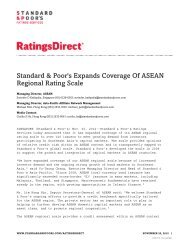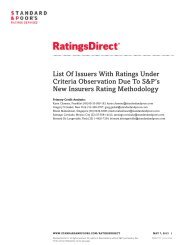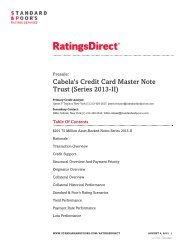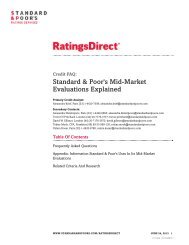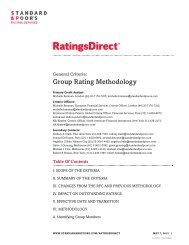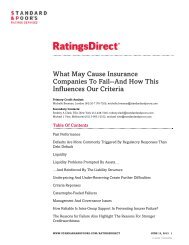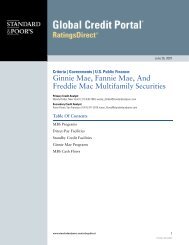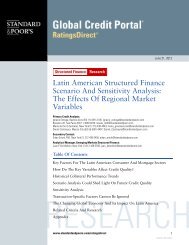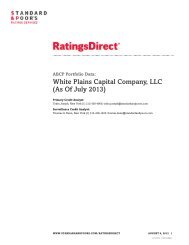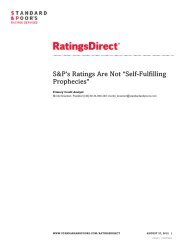General Criteria: <strong>Principles</strong> <strong>Of</strong> <strong>Credit</strong> <strong>Ratings</strong>the rating levels between 'AAA' and 'B' for transactions in certain asset classes. For other asset classes, we createspecific benchmarks, such as coverage multiples or simulated default rates, within a mathematical simulation model.15. Our view on the credit quality of a pool of assets may change over time. The performance of the pool may divergefrom expectations and that divergence may reveal credit strengths or weakness that were not previously apparent.Through our surveillance processes, we reassess the credit quality of the pool based on certain information regardingthe observed performance and other factors we deem relevant.Legal And Regulatory Risks16. <strong>Standard</strong> & <strong>Poor's</strong> assessment of legal and regulatory risks focuses primarily on the degree to which a securitizationstructure isolates the securitized assets from the bankruptcy or insolvency risk of entities that participate in thetransaction. Typically, our analysis focuses on the entity or entities that originated and owned the assets before thesecuritization, although the creditworthiness of other entities also may be relevant. A true sale of the subject assetsfrom the originator/seller to a special purpose entity (SPE) is one method commonly used by an arranger seeking toachieve asset isolation in a securitization. From a legal perspective, a true sale is generally understood to result in theassets ceasing to be part of the seller's bankruptcy or insolvency estate. There may also be other legal mechanisms,apart from true sale, that may achieve analogous comfort. SPEs are entities that typically are used in a securitizationtransaction to "house" the assets that will back the payment obligations usually represented by the securities issuedby the SPE. In the context of our analysis, <strong>Standard</strong> & <strong>Poor's</strong> forms an opinion about the insolvency remoteness ofan SPE based on our evaluation of the specific facts and circumstances that we view as applicable to a particulartransaction. Among other things, the analysis considers whether the separate legal identity of the SPE would berespected by bankruptcy courts or bodies charged with similar functions. In addition, we assess the presence offeatures intended to minimize the likelihood that the SPE itself becomes the subject of bankruptcy.Payment Structure And Cash Flow Mechanics17. The rating analysis for structured finance typically includes an analysis of payment structure and cash flowmechanics. This portion of the analysis may involve both assessing the documentation for a security and testing thecash flows using quantitative models. In both cases, the objective is to assess whether the cash flow from thesecuritized assets would be sufficient, at the applicable rating levels, to make timely payments of interest andultimate payment of principal to the related securities, after taking account of available credit enhancement andallowing for transaction expenses, such as servicing and trustee fees. The analysis may encompass diverse features ofthe payment structure and cash flow mechanics, ranging from the basic payment priorities inherent in a deal (i.e.,the subordination hierarchy of tranches) to the impact of performance covenants (i.e., so-called "triggers") that mayoperate as switches that materially change the distribution priorities if they are breached. Finally, for securities thatembody support facilities from third parties, such as insurance policies, guarantees, bank credit and liquidityfacilities, and derivatives instruments, the analysis focuses on the payment mechanics for those obligations.Operational And Administrative Risks18. The analysis of operational and administrative risks is another part of the structured finance rating analysis. Thispart of the analysis focuses on key transaction parties to determine whether they are capable of managing asecuritization over its life. Key transaction parties may include a transaction's servicer or manager, the asset managerof a collateralized debt obligation (CDO), the trustee, the paying agent, and any other transaction party; herein wecollectively refer to these parties as servicers.19. In securitizations involving many asset classes, the analysis focuses on evaluating a servicer's or manager's ability to<strong>Standard</strong> & Poors | <strong>Ratings</strong>Direct on the Global <strong>Credit</strong> Portal | February 16, 2011 4916650 | 300323561
General Criteria: <strong>Principles</strong> <strong>Of</strong> <strong>Credit</strong> <strong>Ratings</strong>perform its duties, such as receiving timely payments, pursuing collection efforts on delinquent assets, foreclosing onand liquidating collateral, tracking cash receipts and disbursements, and providing timely and accurate investorreports. For transactions that involve revenue-producing assets (e.g., commercial property), the analysis may include,as we deem appropriate, assessment of certain incremental risks associated with managing the assets. For activelymanaged portfolios, the analysis considers the asset manager's capabilities and past performance as an assetmanager.20. The analysis of operational and administrative risks generally considers the possibility that a servicer may becomeunable or unwilling to perform its duties during the life of the transaction. In that vein, the analysis may considerboth the potential for hiring a substitute or successor servicer and any arrangements that provide for a designatedbackup servicer. That portion of the analysis would typically consider the sufficiency of the servicing fee to attract asubstitute, the seniority of the fee in the payment priorities, and the availability of substitute servicers.Counterparty Risk21. The fifth part of the rating analysis is the analysis of counterparty risk. That analysis focuses on third-partyobligations to either hold assets (including cash) or make financial payments that may affect the creditworthiness ofstructured finance instruments. Examples of counterparty risks include exposures to institutions that maintain keyaccounts and exposures to the providers of derivative contracts such as interest rate swaps and currency swaps. Thecounterparty risk analysis considers both the type of dependency and the rating of the counterparty for eachcounterparty relationship in a transaction.FUNDAMENTAL PRINCIPLES OF CORPORATE AND GOVERNMENTRATINGS AND CRITERIA<strong>Credit</strong>worthiness Before External Support22. The most important step in analyzing the creditworthiness of a corporate or governmental obligor is gauging theresources available to it for fulfilling its commitments relative to the size and timing of those commitments.Assessing an obligor's resources for fulfilling its financial commitments is primarily a forward-looking exercise. Itmay entail estimating or projecting future income and cash flows. It may include consideration of economicconditions, the regulatory environment, and economic projections and forecasts. For business entities, future incomeand cash flows may come primarily from ongoing operations or investments. For governmental entities, income andcash flows may come primarily from taxes. In some cases, other resources, including liquid assets or, in the case of asovereign obligor, the ability to print currency, may be relevant.23. The assessment of resources considers both the expected level of future income and cash flows and their potentialvariability. For all types of obligors, the assessment includes both qualitative and quantitative factors.24. The quantitative side of the analysis focuses primarily on financial analysis and may include an evaluation of anobligor's accounting principles and practices.25. For business entities, key financial indicators generally include profitability, leverage, cash flow adequacy, liquidity,and financial flexibility. For financial institutions and insurers, other critical factors may include asset quality,reserves for losses, asset-liability management, and capital adequacy. <strong>Of</strong>f-balance sheet items, such as securitizations,derivative exposures, leases, and pension liabilities, may also be part of the quantitative analysis. Cash flow analysisand liquidity assume heightened significance for firms with speculative-grade ratings ('BB+' and lower).www.standardandpoors.com/ratingsdirect 5916650 | 300323561




